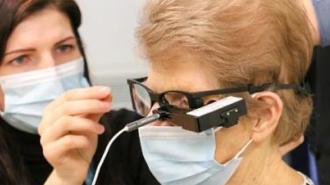Doctors successfully implanted a microchip in a woman’s retina, restoring some vision to her blind eye.
After having normal vision for most of her life, the 88-year-old suffered from dry age-related macular degeneration, causing her to lose sight in one eye.
The implant is being tested in clinical trials in Europe, but this is the first patient to receive it.
“I am thrilled to be the first to have this implant, excited at the prospect of enjoying my hobbies again and I truly hope that many others will benefit from this too.”
The study hopes to show that the implant can partially restore eyesight to people who suffer from geographic atrophy, a disease that currently has no cure. Geographic atrophy is an advanced type of dry age-related macular degeneration (AMD), in which retina cells waste away, resulting in a blind spot.
“Losing the sight in my left eye through dry AMD has stopped me from doing the things I love, like gardening, playing indoor bowls and painting with watercolours,” the woman said in a statement, reports The Guardian.
“I am thrilled to be the first to have this implant, excited at the prospect of enjoying my hobbies again and I truly hope that many others will benefit from this too.”
Surgeons from Moorfields Eye Hospital implanted the 2mm-wide microchip, which was developed by Pixium Vision in France, under the patient’s retina. The chip is a communication “liaison” between customized video glasses linked to a computer the patient wears like a fanny pack.
The camera in the glasses captures visual data, then sends it to the computer. The computer processes the video using artificial intelligence, then relays instructions back to the glasses, telling them where to focus.
After the camera focuses on the primary object, they send visual data — projected as an infrared beam — back through the eye to the chip, reports Science Focus.
At that point, the chip translates it into an electrical signal that travels to the patient’s brain via the retinal cells. The brain learns to interpret this electrical signal as if it were coming from the eye. Voila, the patient can see.
The microchip isn’t effective immediately. It takes up to six weeks and a post-surgery rehabilitation process before the patient can learn to use their newfound vision.
“This groundbreaking device offers the hope of restoration of sight to people suffering vision loss due to dry AMD,” said Mahi Muqit, consultant vitreoretinal surgeon at Moorfields eye hospital.
This is just the latest advance in the field. In November 2021, the same hospital announced that their patient became the world’s first to have a 3D-printed prosthetic eye. And a month earlier, another blind woman was able to partially see again, thanks to a similar prosthetic and brain implant combination.
We’d love to hear from you! If you have a comment about this article or if you have a tip for a future Freethink story, please email us at [email protected].






